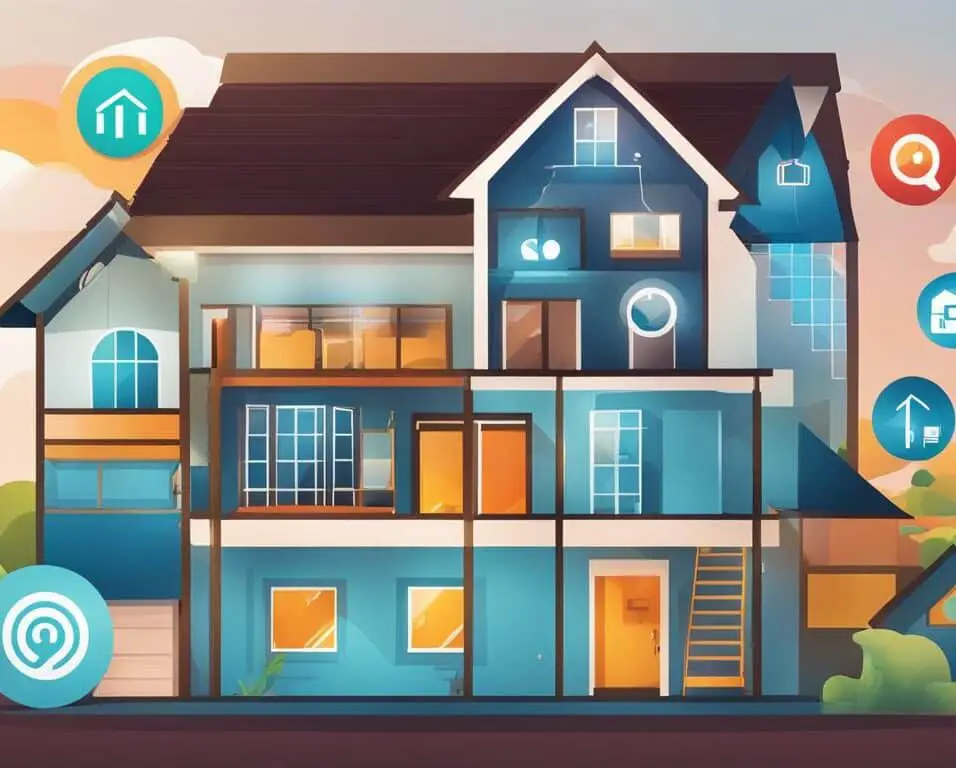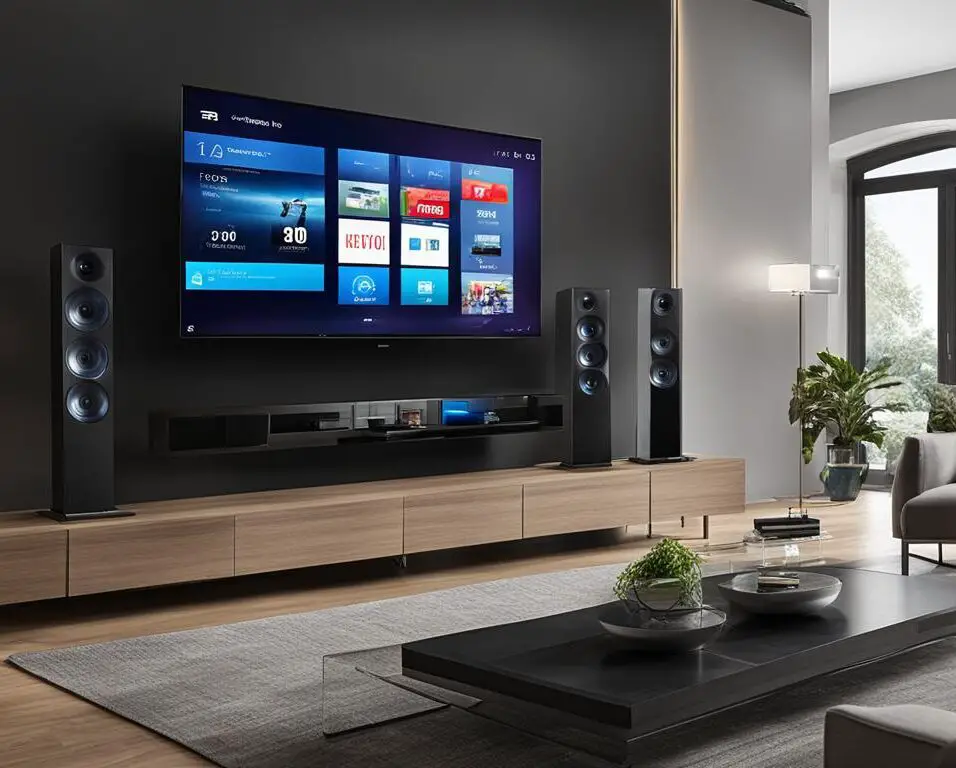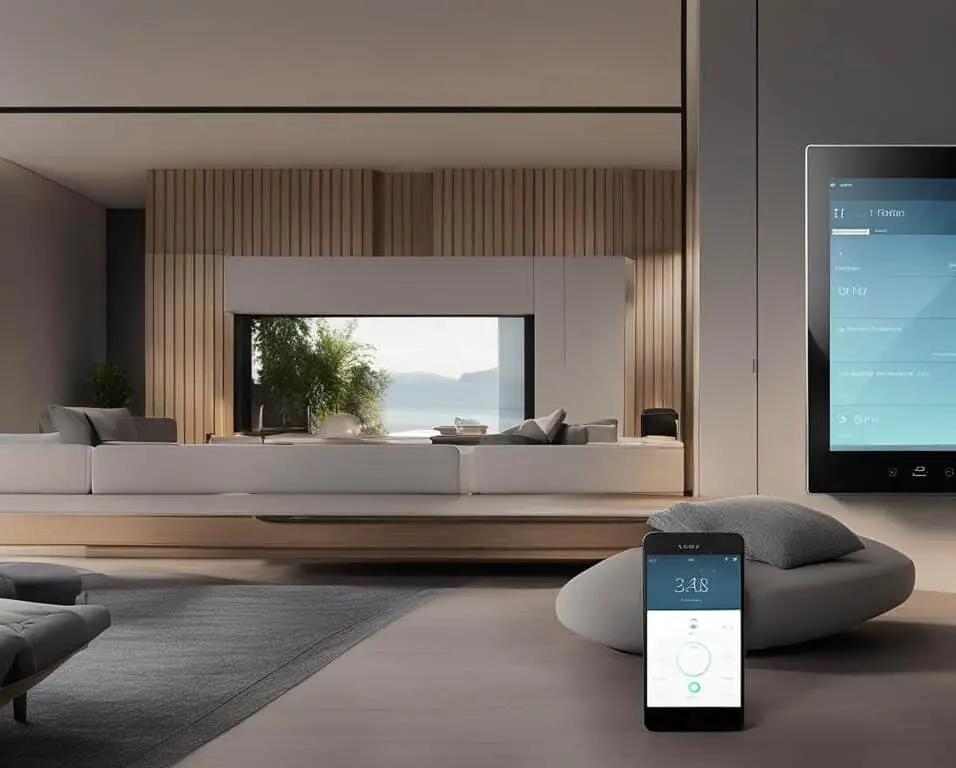The Advantages of Wireless Smart Home Systems
Wireless smart home systems offer a multitude of benefits that can revolutionize and streamline your everyday life. With the rapid advancement of technology, smart home automation has become increasingly popular, providing homeowners with connected home technology that enhances convenience, security, energy efficiency, and customization.
According to industry experts, one of the key advantages of wireless smart home systems is their user-friendly controls. With intuitive interfaces and touchscreen capabilities, managing and monitoring your home security becomes effortless.
Another major advantage is the convenience they offer. With compatibility with mobile apps, you can access and control various aspects of your smart home system from anywhere. Whether you want to adjust the lights, set an alarm, lock the doors, or manage the thermostat, it can all be done remotely with ease.
Enhanced security is also a crucial benefit of wireless smart home systems. With real-time monitoring and communication, you can receive instant alerts and notifications, ensuring the safety of your home and loved ones. Furthermore, these systems can be customized to integrate devices such as motion sensors, cameras, and smart locks, providing a tailored security solution.
Energy savings and management are also key advantages. By utilizing advanced technologies like cloud computing and machine learning, wireless smart home systems optimize energy consumption, helping you reduce your ecological footprint and save on utility bills.
In conclusion, wireless smart home systems bring a host of advantages, including user-friendly controls, convenience, enhanced security, energy savings, and customization. With these systems, you can transform your house into a smart home, simplifying your daily routines and enjoying the benefits of connected home technology.
Key Takeaways:
- Wireless smart home systems offer user-friendly controls and touchscreen interfaces for easy management.
- These systems provide convenience by allowing remote access and control via mobile apps.
- Enhanced security features include real-time monitoring and the ability to integrate various security devices.
- Wireless smart home systems optimize energy consumption, promoting energy savings and reducing utility bills.
- Customization options allow homeowners to tailor their smart home systems to their specific needs and preferences.
How Smart Home Technology Works
Smart home technology revolutionizes the way we interact with our homes by enabling interconnectivity of various devices and systems. With the advent of smart technologies, homeowners can effortlessly control and manage appliances, thermostats, lighting, and security systems from a single device – the smartphone or tablet. This level of interconnectivity offers unparalleled convenience and efficiency in managing daily tasks and routines.
One of the key advantages of smart home technology is the ability to customize preferences and settings. Whether it’s adjusting temperature control, creating lighting schedules, or automating actions based on specific events or time, users have the power to tailor their smart home systems to their unique needs and preferences.
Smart home technology also enhances safety and security by offering real-time monitoring and alerts. Homeowners can remotely monitor their homes, receive instant notifications of suspicious activities, and even communicate with visitors through smart doorbells and cameras. This increased level of safety and security provides peace of mind and reassurance.
In addition to safety and convenience, smart home technology promotes health and wellness tracking. With the integration of smart devices, users can easily monitor and track exercise routines, nutrition, and medication adherence. This seamless integration contributes to a healthier and more balanced lifestyle.
Table: Smart Home Technology Features
| Features | Benefits |
|---|---|
| Interconnectivity | Effortless control and management of multiple devices from a single device |
| Customized Preferences | Personalized settings for temperature control, lighting schedules, and automated actions |
| Increased Safety | Real-time monitoring, instant alerts, and communication with visitors |
| Health and Wellness Tracking | Easy monitoring of exercise routines, nutrition, and medication adherence |
| Energy and Utilities Management | Efficient monitoring and control of energy consumption, saving on utility bills |
Another significant advantage of smart home technology is energy and utilities management. Homeowners can monitor and control their energy consumption, leading to cost savings on utility bills and reducing their environmental impact. From adjusting thermostats to managing lights and monitoring water usage, smart home technology provides efficient and cost-effective solutions.
In conclusion, smart home technology empowers homeowners with a seamless and interconnected living experience. Through enhanced safety features, customized preferences, health and wellness tracking, and energy management capabilities, smart home technology has transformed how we interact with our homes.
Choosing the Right Smart Home System
When it comes to selecting the perfect smart home system, there are several important factors to consider. One of the key advantages of a smart home system is easy interconnectivity. With a wireless system, homeowners can effortlessly link and control multiple devices from a central hub or mobile app. This streamlined setup makes it a breeze to manage various aspects of your home with a few simple taps on your smartphone or tablet.
Remote monitoring capabilities are also crucial when choosing a smart home system. The ability to check in on your home and receive real-time alerts and notifications ensures peace of mind and increased safety. Whether you’re at work or on vacation, you can stay connected to your home and have a clear picture of what’s happening at all times.
Customization options are another essential consideration. The right smart home system allows you to personalize your preferences, creating a truly tailored experience. Whether it’s setting personalized schedules for lighting, temperature control, or security actions, customization ensures that the system caters to your specific needs and lifestyle.
Lastly, energy and utilities management features are critical factors to look for. A smart home system should empower you to monitor and reduce your energy consumption, helping you save on utility bills and reduce your environmental impact. From adjusting thermostats to managing lights and monitoring water usage, an energy-efficient system can bring both cost savings and sustainability to your everyday life.
FAQ
What are the key advantages of wireless smart home systems?
Wireless smart home systems offer user-friendly controls, convenience, better security, energy savings and management, remote access, enhanced monitoring and communication, and customization.
How does smart home technology work?
Smart home technology allows for the interconnectivity of various devices and systems, enabling remote monitoring and control. Users can manage appliances, thermostats, lighting, and security systems from a single device, such as a smartphone or tablet.
How can smart home technology enhance safety and security?
Smart home technology provides real-time monitoring and alerts, allowing homeowners to remotely check in on their homes, receive notifications of suspicious activity, and even communicate with visitors through smart doorbells and cameras.
What benefits does smart home technology offer for energy and utilities management?
Smart home technology enables homeowners to monitor and control their energy consumption, save on utility bills, and reduce their environmental impact. Users can adjust thermostats, manage lights, and monitor water usage for efficient and cost-effective solutions.
What factors should I consider when choosing a smart home system?
When choosing a smart home system, it’s important to consider factors such as ease of interconnectivity, remote monitoring capabilities, customization options, increased safety features, and energy and utilities management. Working with a reputable provider is also recommended.








